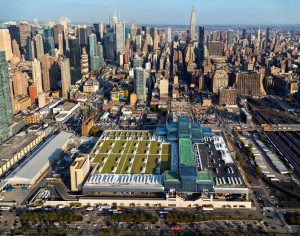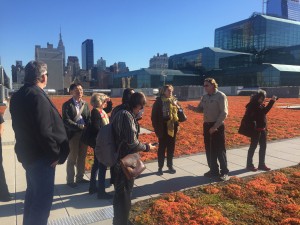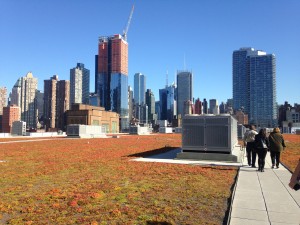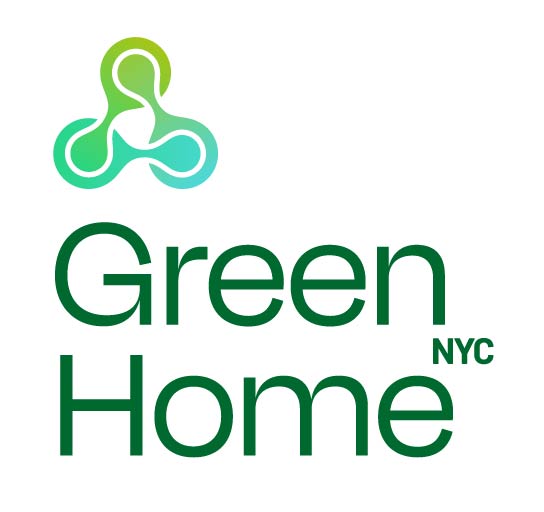by Shari Baitcher
In New York, a city with one of the highest population densities in the U.S., every

square foot is valuable. In recent years more thought has been given to the space on top of buildings. With 840,000 square feet of exhibition space occupying 6 city blocks, the Jacob K. Javits Convention Center has recently introduced the second largest green roof in the United States.
Rick Brown, Chief Engineer for the Javits Center, exuded passion for the recently implemented sustainability project as he took GreenHomeNYC volunteers and community members behind the scenes of the convention center. We stopped at the IT office where he explained how they capture the heat generated by the computers and servers to help offset the building’s heating demand. Sensors have been installed all over the building to monitor efficiency, revealing a 26% reduction in energy consumption since the renovations have been completed. Additionally, water consumption has been reduced by 2.9 million gallons. Efficiency measures such as these contribute towards the Javits Center’s goal of earning LEED Silver certification.
We then went upstairs and entered the massive green roof. This incredible expanse of greenery in the heart of New York City is the size of five football fields. Rick explained that the roof is covered with sedum plants, which were grown in Syracuse, NY. He lifted up a small patch to show us the layers underneath and revealed how rain water is absorbed. In urban settings, storm water flows along sidewalks and roads collecting pollutants before entering, and sometimes overwhelming, the sewage system. The green roof absorbs about 70% of storm water run-off, collecting up to 6.8 million gallons of water annually. Rick explained they are conscious of not wasting water and plan to implement a system to collect condensation from the air conditioning units as well. The green roof is also great for temperature regulation. The temperature tends to stay approximately 10 degrees cooler in the summer and 10 degrees warmer in cooler months. Traditional roofs are often dark in color and generate more heat.

The roof is home to a thriving eco-system. There are microphones monitoring 5 different types of bats as well as a section containing bee hives with bees producing honey. The building’s standard glass panels have recently been replaced with energy efficient glazing composed of speckled glass, which makes it easier for birds to see and prevents collisions.
The renovation provides an amazing opportunity for students to learn about sustainability, bio-diversity, green innovation, and eco-systems. Currently the Audubon Society, Drexel University, Cooper Union, and Fordham University students are conducting experiments and collecting invaluable data from this space.
The green roof is an excellent addition to this populous city. It not only increases the aesthetic for surrounding buildings but also offers huge benefits for the community. It provides opportunities for energy efficiency, educational collaborations, water conservation and a habitat for quite a few species. With such a huge operation, even seemingly small changes can have a significant impact. The Javits Center efficiency and environmental improvements exemplify green options for NYC. Hopefully these successful renovations will inspire other businesses to make beneficial changes and gain more momentum in the sustainability movement.

 square foot is valuable. In recent years more thought has been given to the space on top of buildings. With 840,000 square feet of exhibition space occupying 6 city blocks, the Jacob K. Javits Convention Center has recently introduced the second largest green roof in the United States.
Rick Brown, Chief Engineer for the Javits Center, exuded passion for the recently implemented sustainability project as he took GreenHomeNYC volunteers and community members behind the scenes of the convention center. We stopped at the IT office where he explained how they capture the heat generated by the computers and servers to help offset the building’s heating demand. Sensors have been installed all over the building to monitor efficiency, revealing a 26% reduction in energy consumption since the renovations have been completed. Additionally, water consumption has been reduced by 2.9 million gallons. Efficiency measures such as these contribute towards the Javits Center’s goal of earning LEED Silver certification.
We then went upstairs and entered the massive green roof. This incredible expanse of greenery in the heart of New York City is the size of five football fields. Rick explained that the roof is covered with sedum plants, which were grown in Syracuse, NY. He lifted up a small patch to show us the layers underneath and revealed how rain water is absorbed. In urban settings, storm water flows along sidewalks and roads collecting pollutants before entering, and sometimes overwhelming, the sewage system. The green roof absorbs about 70% of storm water run-off, collecting up to 6.8 million gallons of water annually. Rick explained they are conscious of not wasting water and plan to implement a system to collect condensation from the air conditioning units as well. The green roof is also great for temperature regulation. The temperature tends to stay approximately 10 degrees cooler in the summer and 10 degrees warmer in cooler months. Traditional roofs are often dark in color and generate more heat.
square foot is valuable. In recent years more thought has been given to the space on top of buildings. With 840,000 square feet of exhibition space occupying 6 city blocks, the Jacob K. Javits Convention Center has recently introduced the second largest green roof in the United States.
Rick Brown, Chief Engineer for the Javits Center, exuded passion for the recently implemented sustainability project as he took GreenHomeNYC volunteers and community members behind the scenes of the convention center. We stopped at the IT office where he explained how they capture the heat generated by the computers and servers to help offset the building’s heating demand. Sensors have been installed all over the building to monitor efficiency, revealing a 26% reduction in energy consumption since the renovations have been completed. Additionally, water consumption has been reduced by 2.9 million gallons. Efficiency measures such as these contribute towards the Javits Center’s goal of earning LEED Silver certification.
We then went upstairs and entered the massive green roof. This incredible expanse of greenery in the heart of New York City is the size of five football fields. Rick explained that the roof is covered with sedum plants, which were grown in Syracuse, NY. He lifted up a small patch to show us the layers underneath and revealed how rain water is absorbed. In urban settings, storm water flows along sidewalks and roads collecting pollutants before entering, and sometimes overwhelming, the sewage system. The green roof absorbs about 70% of storm water run-off, collecting up to 6.8 million gallons of water annually. Rick explained they are conscious of not wasting water and plan to implement a system to collect condensation from the air conditioning units as well. The green roof is also great for temperature regulation. The temperature tends to stay approximately 10 degrees cooler in the summer and 10 degrees warmer in cooler months. Traditional roofs are often dark in color and generate more heat.
 The roof is home to a thriving eco-system. There are microphones monitoring 5 different types of bats as well as a section containing bee hives with bees producing honey. The building’s standard glass panels have recently been replaced with energy efficient glazing composed of speckled glass, which makes it easier for birds to see and prevents collisions.
The renovation provides an amazing opportunity for students to learn about sustainability, bio-diversity, green innovation, and eco-systems. Currently the Audubon Society, Drexel University, Cooper Union, and Fordham University students are conducting experiments and collecting invaluable data from this space.
The green roof is an excellent addition to this populous city. It not only increases the aesthetic for surrounding buildings but also offers huge benefits for the community. It provides opportunities for energy efficiency, educational collaborations, water conservation and a habitat for quite a few species. With such a huge operation, even seemingly small changes can have a significant impact. The Javits Center efficiency and environmental improvements exemplify green options for NYC. Hopefully these successful renovations will inspire other businesses to make beneficial changes and gain more momentum in the sustainability movement.
The roof is home to a thriving eco-system. There are microphones monitoring 5 different types of bats as well as a section containing bee hives with bees producing honey. The building’s standard glass panels have recently been replaced with energy efficient glazing composed of speckled glass, which makes it easier for birds to see and prevents collisions.
The renovation provides an amazing opportunity for students to learn about sustainability, bio-diversity, green innovation, and eco-systems. Currently the Audubon Society, Drexel University, Cooper Union, and Fordham University students are conducting experiments and collecting invaluable data from this space.
The green roof is an excellent addition to this populous city. It not only increases the aesthetic for surrounding buildings but also offers huge benefits for the community. It provides opportunities for energy efficiency, educational collaborations, water conservation and a habitat for quite a few species. With such a huge operation, even seemingly small changes can have a significant impact. The Javits Center efficiency and environmental improvements exemplify green options for NYC. Hopefully these successful renovations will inspire other businesses to make beneficial changes and gain more momentum in the sustainability movement.


Leave a Reply
You must be logged in to post a comment.